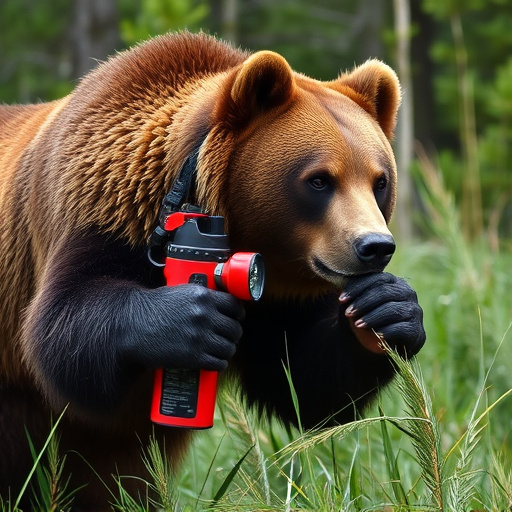Bear spray effectiveness relies on capsaicin concentration, with 2% to 4% ranges recommended for safety and efficacy. Higher concentrations like 10%+ offer better protection but require careful handling. Proper application involves short bursts at close range targeting bear faces and eyes, ensuring accurate deployment through regular practice. Choosing the right spray considers capsaicin, brand quality, spray pattern, range, and ease of use for reliable self-defense in bear encounters.
Staying safe in bear country requires more than just knowledge; it demands effective tools. One such tool gaining prominence is bear spray, a powerful deterrent that uses capsaicin concentration to keep predators at bay. This article delves into the science behind bear spray, exploring how capsaicin concentrations determine its effectiveness. We’ll guide you through application techniques for maximum protection and help choose the right bear repellent based on specific needs.
- Understanding Bear Spray: How It Works
- Deciphering Capsaicin Concentrations: What Matters
- Effective Use: Application Techniques for Maximum Protection
- Choosing the Right Bear Repellent: Factors to Consider
Understanding Bear Spray: How It Works
Bear spray, also known as bear repellent, is a powerful tool for self-defense against predatory bears. Its primary active ingredient is capsaicin, the same chemical that gives chili peppers their heat and numbing sensation. The capsaicin concentration in bear repellent plays a crucial role in its effectiveness.
When used correctly, bear spray creates an aerosolized mist that delivers a high concentration of capsaicin into the eyes and respiratory system of the target animal. This potent irritant temporarily blinds and disorients the bear, providing the user with valuable time to escape or defend themselves. The capsaicin concentration typically ranges from 2% to 4%, ensuring both potency and safety for users.
Deciphering Capsaicin Concentrations: What Matters
The effectiveness of bear spray as a defense mechanism hinges on understanding the capsaicin concentration, the active ingredient responsible for its pungent properties. This chemical compound is derived from chili peppers and has become a staple in wildlife deterrents due to its ability to temporarily incapacitate predators. The key lies in the measurement of capsaicin in parts per million (ppm).
A higher ppm indicates greater potency, ensuring a more powerful reaction when sprayed towards an attacking bear or other large predator. Products with concentrations ranging from 2% to 4% are commonly recommended for bear encounters. This range offers a balance between affordability and performance, providing users with enough strength to deter an approaching threat while being cost-effective.
Effective Use: Application Techniques for Maximum Protection
To ensure maximum protection against predators like bears, understanding and applying bear spray effectively is paramount. The key lies in knowing the capsaicin concentration in your repellent – a higher concentration offers greater efficacy. Aim for products with at least 2% capsaicin, as this level has proven effective in deterring aggressive encounters.
Application technique plays an equally vital role. When faced with a bear, spray in short bursts at close range, roughly 15-20 feet away. Target the animal’s face and eyes, as the irritant acts on sensory organs to create a distraction and escape behavior. Practice these techniques regularly to build confidence and ensure you can deploy the spray accurately under stress.
Choosing the Right Bear Repellent: Factors to Consider
When selecting a bear spray for defense, understanding the capsaicin concentration is key. Capsaicin, the active ingredient, varies significantly between products and directly correlates with its effectiveness against predators. Higher concentrations offer greater protection, especially in potent forms like 10% or higher capsaicin levels. This ensures a stronger reaction from bears when sprayed.
Other factors to consider include brand reputation, spray pattern, range, and ease of use. Reputable brands invest in research and quality control, guaranteeing product consistency. A wide spray pattern covers more ground, while a good range allows for safe distance during encounters. User-friendly designs with reliable triggers enhance the overall experience, making it easier to deploy the spray when needed.
Bear spray has proven to be an effective defense mechanism against predators, with its capsaicin concentration playing a pivotal role in deterring bears. Understanding how bear spray works and mastering application techniques are key to ensuring maximum protection during outdoor activities in bear country. When choosing a repellent, considering factors like capsaicin concentration, canes, and range will empower you to make an informed decision, enhancing your safety and peace of mind in the wild.
